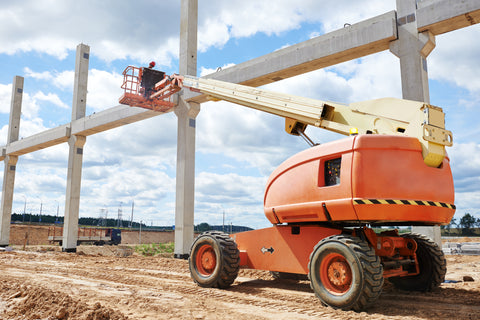Initially, boom lifts provide an important component in many large construction projects. For example, depending on the scale and scope of the project, boom lifts help provide a safe working platform, which reduces accidents and liability concerns. However, now, boom lifts remain one of the favorite options for the power and telecommunications field, among other industries and specialities, such as:
- Landscapers utilize to cut trees.
- Firefighters utilize to move or access hard to reach levels of a building.
- Window cleaners use to reach certain windows.
Technically, boom lifts are part of the aerial work platform (AWP) family. As a result, they share similar features and functions as scissor lifts. But, boom lifts specialize in different working conditions, which have expanded over time.
“Boom lifts were once exclusively operated by hydraulic pistons, powered by diesel or gasoline motors on the base unit. Lightweight electrically powered units are gaining popularity for window-cleaning or other maintenance operations, especially indoors and in isolated courtyards, where heavier hydraulic equipment cannot be used. Boom lifts are the closest in appearance to a crane, consisting of a number of jointed sections, which can be controlled to extend the lift in a number of different directions, which can often include "up and over" applications.”
Additionally, boom lifts gained notoriety and adoption because they provide easy access to awkward to reach positions, which require some sort of work. Boom lifts differ from scissor lifts because they feature a bucket. Conversely, scissor lifts include a larger platform. As a result, boom lifts help workers reach elevated levels, but remain nimble, so they provide access to difficult-to-reach spaces.
Finally, boom lifts, which were originally known as cherry pickers because farmers started using them in orchards to pick fruit off trees without damaging the trees themselves.
Articulating Boom Lift vs Telescopic Boom Lift
Although known as a few different things, there are two main types of boom lifts. Articulating boom lifts, which include those “cherry pickers” and telescopic boom lifts. Additionally, certain lifts are also known as spider lifts, which is due to the base. In these boom lifts, “legs” unfold from the base, which provides additional stabilization (but the type of lift itself remains an articulating or telescopic boom lift).
- Articulating Boom Lift

Articulating boom lifts (occasionally known as knuckle boom lifts) are the most common type of AWP. Additionally, these aerial lifts offer a distinctive shape, which allows operators to maneuver the work platform to awkward places. Articulating lifts include various stabilization mechanisms (depending on the make and model) that allows operators to utilize on unstable ground or steep inclines.
Ultimately, articulating lifts provide operators with the ability to move up, over and out with precision. This versatility ensures obstacles do not hinder completion of various projects or hard to maintain areas.
- Telescopic Boom Lift

Telescopic boom lifts (also known as a straight boom lift) extends straight out of the base. These lifts include various sections that fold together like a telescope. During use, the sections expand, which allows the lift to elevate diagonally or vertically to take advantage of the complete boom length.
Ultimately, telescopic lifts provide operators the ability to move horizontally or vertically in order to take workers exactly where they are needed.
Additional Boom Lift Information
In addition to articulating vs telescopic boom lift questions, there are also different types of motors. For example, boom lifts are either electronic or towable. Additionally, certain people are interested in leveraging boom lifts as cranes. Unfortunately, due to OSHA regulations boom lifts are prohibited from use outside of their intended use (which would include crane functionality).
Another interesting question relates to the heights that boom lifts can reach. As expected, the maximum heights vary by manufacturer, make and model. For example, two of the leading aerial lift manufacturers, Genie and JLG, make boom lifts that range from 30 to over 150 feet based on model and articulating vs telescoping lifts.
Additionally, many individuals just getting started are interested in more information regarding horizontal reach. Essentially, horizontal reach is the distance the platform can safely reach away from the boom lift base. Keep in mind that the vertical reach will be much higher than the horizontal reach.
Finally, where do you find replacement parts for your boom lift? Aerial Equipment Parts is your answer because we provide a vast selection of boom lift replacement parts for all of the leading brands. From JLG and Genie to SkyJack and Snorkel lifts, if you need any replacement part for your boom lift, then search our inventory or call/e-mail with any questions! Our staff has years of industry experience and is fully knowledgeable on all products.
Shop our pages for quality products from the most trusted names in the industry. Products are available at the most competitive prices and are shipped fast! NOTE: Please verify the correct part number for your machine before ordering. Order with Aerial Equipment Parts and enjoy expert customer service from years of industry experience.
Shop today!

